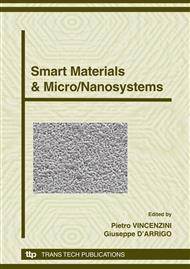[1]
R. Saito, G. Dresselhaus, and M. S. Dresselhaus, Physical Properties of Carbon Nanotubes (Imperial College Press, London, 1998); M. S. Dresselhaus, G. Dresselhaus, and P. Avouris, Carbon Nanotubes (Springer, Heidelberg, 2001).
DOI: 10.1142/p080
Google Scholar
[2]
J. Bernholc, D. Brenner, M. Buongiorno Nardelli, V. Meunier and C. Roland, Annu. Rev. Mat. Res. 32, 347 (2002).
DOI: 10.1146/annurev.matsci.32.112601.134925
Google Scholar
[3]
J. Kong; E. Yenilmez; T.W. Tombler; W. Kim; H. Dai; R.B. Laughlin; L. Liu; C.S. Jayanthi; S.Y. Wu, Phys. Rev. Lett. 87, 106801, (2001).
DOI: 10.1103/physrevlett.87.106801
Google Scholar
[4]
M.F. Yu, O. Lourie, M.J. Dyer, K. Moloni, T.F. Kelly, R.S. Ruoff, Science 287, 637 (2000).
Google Scholar
[5]
D. Tekleab, D.L. Carroll, G.G. Samsonidze, B. I. Yakobson, Phys. Rev. B 64, 035419 (2001).
Google Scholar
[6]
S. Frank, P. Poncharal, Z. L. Wang, W. A. de Heer, Science 280, 1744 (1998).
Google Scholar
[7]
R. Gupta, R.E. Smallcup, M. in het Panhuis, Nanotechnology 16, 1707 (2005).
Google Scholar
[8]
C. Schönenberger, A. Bachtold, C. Strunk, J.P. Salvetat, L. Forro', Appl. Phys. A 69, 283 (1999).
Google Scholar
[9]
A. Batchtold, C. Strunk, J.P. Salvetat, J.M. Bonard, L. Forro', T. Nussbaumer, C. Schönenberger, Nature (London) 397, 673 (1999).
DOI: 10.1038/17755
Google Scholar
[10]
B. Bourlon, C. Miko, L. Forró, D. C. Glattli, A. Bachtold, Phys. Rev. Lett. 93, 176806 (2004).
DOI: 10.1103/physrevlett.93.176806
Google Scholar
[11]
S. Roche, F. Triozon, A. Rubio, D. Mayou, Phys. Lett. A 285, 94 (2001).
Google Scholar
[12]
P.G. Collins, Ph. Avouris, Appl. Phys. A 74, 329-332 (2002).
Google Scholar
[13]
S. Paulson, M. R. Falvo, N. Snider, A. Helser, T. Hudson, A. Seeger, R. M. Taylor, R. Superfine, and S. Washburna, Appl. Phys. Lett. 75, 2936 (1999).
DOI: 10.1063/1.125193
Google Scholar
[14]
E. D. Minot, Y. Yaish, V. Sazonova, J. Park, M. Brink, and P. L. McEuen. Phys. Rev. Lett. 90, 156401 (2003).
DOI: 10.1103/physrevlett.90.156401
Google Scholar
[15]
B. Liu, H. Jiang, H. T. Johnson, Y. Huang, J. Mech. Phys. Solids 52, 1 (2004).
Google Scholar
[16]
A. Maiti, A. Svizhenko, and M. P. Anantram, Phys. Rev. Lett. 88, 126805 (2002).
Google Scholar
[17]
J. Lu, J. Wu, W. Duan, F. Liu, B. Zhu, and B. Gu, Phys. Rev. Lett. 90, 156601 (2003).
Google Scholar
[18]
A.A. Farajian, B.I. Yakobson, H. Mizuseki, Y. Kawazoe1. Phys. Rev. B 67, 205423 (2003).
Google Scholar
[19]
M. Buongiorno Nardelli, Phys. Rev. B 60, 7828 (1999). The computer code DOSQC ver. 1.0 is freely available at http://ermes.physics.ncsu.edu.
Google Scholar
[20]
A. Rochefort, P. Avouris, F. Lesage, D. R. Salahub, Phys. Rev. B 60, 13824 (1999).
Google Scholar
[21]
L. Yang and J. Han, Phys. Rev. Lett. 85, 154 (2000).
Google Scholar
[22]
M. A. Tunney, N. R. Cooper, Phys. Rev. B, 74, 075406 (2006).
Google Scholar
[23]
S. Sanvito, Y. Kwon, D. Tománek, C. J. Lambert, Phys. Rev. Lett., 84, 1974 (2000).
Google Scholar
[24]
P. Delaney, M. Di Ventra, S.T. Pantelides, Appl. Phys. Lett., 75, 3787 (1999).
Google Scholar
[25]
Y. Kwon, D. Tománek, Phys. Rev. B, 58, R16001 (1998).
Google Scholar
[26]
H. J. Choi, J. Ihm, Y. Yoon, S. G. Louie, Phys. Rev. B, 58, R14009 (1999).
Google Scholar
[27]
R. H. Baughman, A. A. Zakhidov, W. A. de Heer, Science 297, 787 (2002).
Google Scholar
[28]
A. Pantano, D. M. Parks and M. C. Boyce, Phys. Rev. Lett. 91, 145504 (2003).
Google Scholar
[29]
A. Pantano, M. C. Boyce and D. M. Parks, J. Mech. Phys. Solids 52, 789 (2004).
Google Scholar
[30]
A. Pantano, M. C. Boyce and D. M. Parks, J. of Eng. Materials and Technology Trans. ASME 126, 279 (2004).
Google Scholar
[31]
A. Pantano, D. M. Parks, M. C. Boyce, M. Buongiorno Nardelli, J. of Applied Physics, 92, 6756 (2004).
Google Scholar
[32]
Xu, Wang, Chan, and Ho, J. Phys.: Condens. Matter 4 6047 (1992); Charlier, Lambin and Ebbesen, Phys. Rev. B, 54, R8377 (1997); Porezag, Frauenheim, Kohler, Seifert and Kaschner, Phys. Rev. B 51, 12947 (1995).
DOI: 10.1103/physrevb.51.12947
Google Scholar
[33]
V. Meunier, M. Buongiorno Nardelli, C. Roland, J. Bernholc, Phys. Rev. B, 64, 195419 (2001).
Google Scholar
[34]
T. Kuzumaki, Y. Mitsuda, Appl. Phys. Lett., 85, 1250 (2004).
Google Scholar


